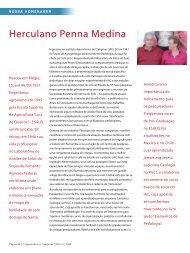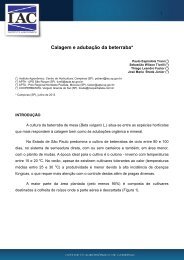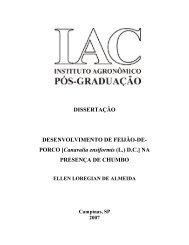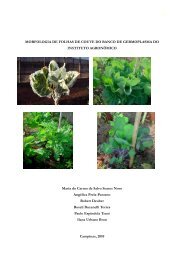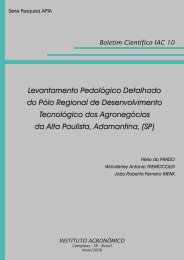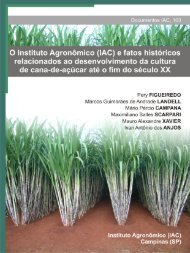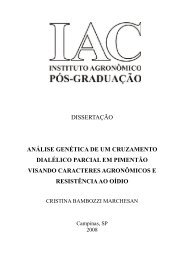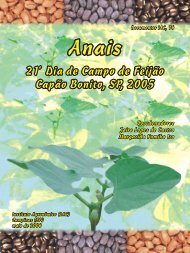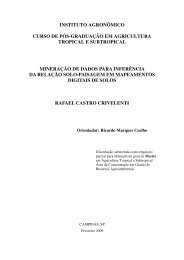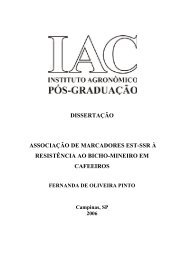vi seminário sobre pragas, doenças e plantas daninhas do ... - IAC
vi seminário sobre pragas, doenças e plantas daninhas do ... - IAC
vi seminário sobre pragas, doenças e plantas daninhas do ... - IAC
- No tags were found...
Create successful ePaper yourself
Turn your PDF publications into a flip-book with our unique Google optimized e-Paper software.
axonopodis pv. phaseoli), are some of the most harmful diseases that occur at common bean culture<br />
(Phaseolus vulgaris) in the São Paulo State. The use of genotypes with genetic resistance is the diseases´s<br />
farming ideal form, but there are not genotypes with multiple resistance. At this case, this paper armed<br />
the identification of genotypes with resistance of the mainly common bean diseases. It was used the<br />
ran<strong>do</strong>mized blocks design with 19 genotypes – <strong>IAC</strong>-Carioca Tybatã, <strong>IAC</strong>-Una, FT-Nobre, Pérola, Gen<br />
96A98-15-3-52-1 (<strong>IAC</strong>/Carioca), Gen 96A45-3-51-52-1 (<strong>IAC</strong>/Carioca), Gen 96A98-13-1-52-1 (<strong>IAC</strong>/Carioca),<br />
Gen 96A98-5-1-1-55 (<strong>IAC</strong>/Preto), Gen 96A98-5-1-1-55 (<strong>IAC</strong>/Preto), Gen 96A3-P1-1-1 (<strong>IAC</strong>/Preto), LP 98-<br />
122 (IAPAR/Preto), LP 02-130 (IAPAR/Preto), LP 01-38 (IAPAR/Carioca), LP 9979 (IAPAR/Carioca),<br />
BRS-Pontal (Embrapa/Carioca), BRS-Requinte (Embrapa/Carioca), BRS-Triunfo (Embrapa/Preto), BRS-<br />
Grafite (Embrapa/Preto), CV-48 (UFLA/Carioca) and Z-28 (UFLA/Carioca), with three replications. The<br />
diseases were evaluated at the two central lines. Data were submitted of statistics analysis and the<br />
averages were compared by the Tukey test with probability of 5%. The results had e<strong>vi</strong>denced that all the<br />
evaluated genotypes presented low incidence of diseases, that the angular leaf spot was the disease<br />
that occurred with higher severity by the evaluated genotypes and, that the climatic conditions were not<br />
favorable for other diseases occurrence.<br />
Key words: Phaseolus vulgaris L., leaf diseases.<br />
1. INTRODUÇÃO<br />
O feijão é uma das mais importantes fontes de proteína vegetal para o povo brasileiro, seu<br />
maior consumi<strong>do</strong>r mundial. O Brasil, por sua vez, é o maior produtor mundial de feijão, apresentan<strong>do</strong>,<br />
porém, baixas produti<strong>vi</strong>dades, quan<strong>do</strong> compara<strong>do</strong> a outros países ou com o potencial produtivo <strong>do</strong>s<br />
cultivares. Entre os mais importantes fatores da baixa produti<strong>vi</strong>dade encontram-se as <strong>do</strong>enças que,<br />
em alguns casos, constituem fator limitante da cultura.<br />
Alternativas para o controle de <strong>do</strong>enças <strong>do</strong> feijoeiro são citadas na literatura, sen<strong>do</strong>, porém, a<br />
resistência genética a de menor custo ao produtor e a de maior eficiência de controle. Apesar de<br />
todas as vantagens ad<strong>vi</strong>ndas da inserção de resistência às <strong>do</strong>enças nas <strong>plantas</strong>, o melhoramento<br />
não é capaz, pela complexidade, de conferir níveis adequa<strong>do</strong>s a todas elas.<br />
Nesse senti<strong>do</strong>, o objetivo <strong>do</strong> trabalho foi avaliar a ocorrência de <strong>do</strong>enças em genótipos de<br />
feijoeiro com características promissoras e que estão sen<strong>do</strong> submetidas aos testes de valor de<br />
cultivo e uso, <strong>vi</strong>san<strong>do</strong> o registro de cultivares de feijoeiro para o Esta<strong>do</strong> de São Paulo.<br />
2. MATERIAL E MÉTODOS<br />
O experimento foi realiza<strong>do</strong> em Capão Bonito - SP, no Pólo Regional de Desenvol<strong>vi</strong>mento<br />
Tecnológico <strong>do</strong>s Agronegócios <strong>do</strong> Su<strong>do</strong>este Paulista - APTA/SAA. O clima da região é <strong>do</strong> tipo Cfa, ou<br />
seja, mesotérmico úmi<strong>do</strong> sem estação marcadamente seca, temperatura média anual de 18,8ºC e<br />
precipitação média anual de 1.236mm, com altitude de 700m. A adubação básica de semeadura foi<br />
realizada manualmente, aplican<strong>do</strong>-se 215kg.ha -1 da fórmula 08-28-16. A adubação de cobertura foi<br />
realizada 20 dias após a emergência, com 70kg.ha -1 de N, na forma de uréia. As sementes não<br />
foram tratadas e, na semeadura, utilizaram-se 15 sementes por metro, com espaçamento de 0,5m<br />
entre linhas, para se obter, após desbaste, população de 240.000 <strong>plantas</strong> por hectare. Cada parcela<br />
Documentos, <strong>IAC</strong>, Campinas, 79, 2007<br />
207



